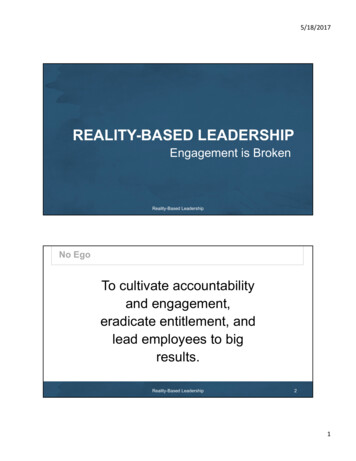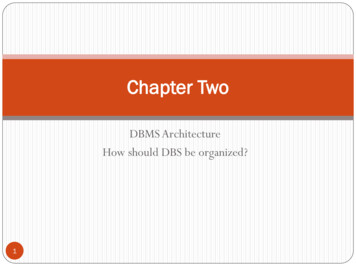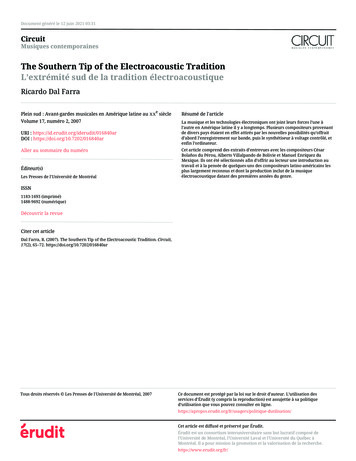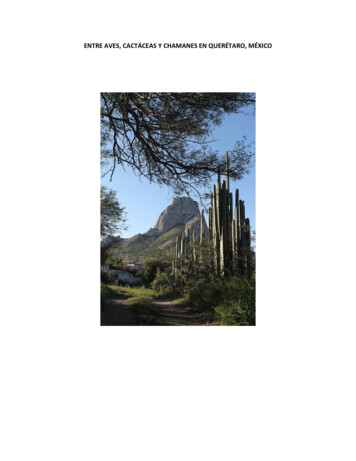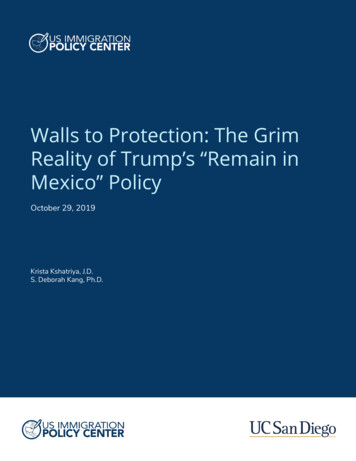
Transcription
Walls to Protection: The GrimReality of Trump’s “Remain inMexico” PolicyOctober 29, 2019Krista Kshatriya, J.D.S. Deborah Kang, Ph.D.
Contents2Background3Legal Challenges to MPP6Concerns about Implementation8-CBP Processing Upon Arrival8-Fear Screening12-Immigration Court Hearings for MPP Asylum Seekers13
BackgroundOn December 20, 2018, the Department of Homeland Security (DHS) announced the MigrantProtection Protocols (MPP), a new policy that returns asylum seekers to Mexico for the duration oftheir immigration proceedings.1 DHS began implementing MPP at the San Ysidro port of entry atthe end of January 2019. By the end of May 2019, MPP was expanded across the entire southernborder.2During the first two weeks of MPP, single adults from El Salvador, Guatemala, and Honduras werereturned to Mexico.3 However, beginning as early as February 13, DHS began sending families toMexico under MPP.4 In June, the administration expanded MPP to cover anyone from aSpanish-speaking country, which has led to large numbers of Cubans, Venezuelans, andNicaraguans, among others, being returned to Mexico.5 Currently, approximately 50,000 asylumseekers have been returned to Mexico under MPP.6 This includes nearly 16,000 children under 18,4,300 children under 5 years old, and nearly 500 infants.7DHS maintains that the measure will “address the urgent humanitarian and security crisis” on theUS-Mexico border and restore the rule of law to a broken asylum system.8 Yet, MPP raises a numberof questions about whether the president has the authority to apply MPP to asylum seekers arrivingat the southern border, whether asylum seekers will be returned to a place where their life andfreedom are threatened, and whether they can meaningfully exercise their right to apply forhumanitarian relief in the U.S.1Department of Homeland Security, Press Release, “Secretary Kirstjen M. Nielsen Announces Historic Action to Confront IllegalImmigration,” December 20, 2018, accessed February 18, l-immigration.2US Customs and Border Protection, Memorandum, “Implementation of the Migrant Protection Protocols,” January 28, 2019, accessedFebruary 18, 2019, ection-protocols; Dara Lind, “‘Remain in Mexico’: Trump’squietly expanding crackdown on asylum seekers, explained,” Vox, March 5, 2019, accessed March 10, -protection-protocols-border-asylum-trump-mexico; Joel Rose, “‘Remain in Mexico’Immigration Policy Expands, But Slowly,” NPR, March 12, 2019, accessed October 14, y; Aaron Montes, “El Paso beginsTrump policy that sends migrant asylum seekers back to Mexico,” El Paso Times, March 26, 2019, accessed October 14, juarez/3177682002/; Human Rights First, “Delivered to Danger: Illegal Remain in Mexico Policy Imperils AsylumSeekers’ Lives and Denies Due Process,” August 2019, 21, accessed October 18, Human Rights First, “A Sordid Scheme: The Trump Administration’s Illegal Return of Asylum Seekers to Mexico,” February 2019, 2,accessed February 18, asylum-seekers-mexico.4Lind, “‘Remain in Mexico’: Trump’s quietly expanding crackdown,”; Complaint, Innovation Law Lab, et al. v. Nielsen, No. 3:19-cv-008007(N.D. Cal. February 14, 2019), 16, accessed October 16, n-law-lab-v-nielsen-complaint; Adolfo Flores, “The Trump Administration has Sent theFirst Asylum-Seeking Families Back to Mexico,” BuzzFeed, February 14, 2019, accessed February 16, -asylum-seeking; Sarah Kinosian, “EntireFamilies of Asylum Seekers are Being Returned to Mexico, Leaving them in Limbo,” Washington Post, February 15, 2019, accessedFebruary 16, b-11e9-8781-763619f12cb4 story.html?noredirect on&utm term .c8405a27e1cf.5Jonathan Blitzer, “How the U.S. Asylum System is Keeping Migrants at Risk in Mexico,” The New Yorker, October 1, 2019, accessedOctober 16, 2019, co.6Kristina Cooke, Mica Rosenberg, and Reade Levinson, “Exclusive: U.S. migrant policy sends thousands of children, including babies, backto Mexico,” Reuters, October 11, 2019, accessed October 16, exico-idUSKBN1WQ1H1.7Ibid.8Lind, “ ‘Remain in Mexico’: Trump’s quietly expanding crackdown,”; Department of Homeland Security, Press Release, “MigrantProtection Protocols,” January 24, 2019, accessed February 18, rotection-protocols; Department of Homeland Security, Press Release, December 20,2018.3
Under MPP, asylum seekers arriving at the southern border are processed by Customs and BorderProtection (CBP) officials, given a “Notice to Appear” for their court hearing, and then returned toMexico for the duration of their asylum proceedings.9 In some cases, migrants are processed at oneborder port of entry but, due to capacity problems, are transported to neighboring ports of entry forremoval to Mexico.10 The decision to place someone arriving at the southern border without properdocumentation into MPP is supposed to be a matter of discretion determined by DHS officials on acase-by-case basis.11 Those explicitly excluded from MPP include: Mexican citizens, individuals inexpedited removal proceedings, and vulnerable groups such as unaccompanied children andindividuals with known physical and/or mental health issues, among others.12 However, there havebeen reports that DHS has placed individuals into MPP who should have fit these exemptions.13 Forexample, see the companion report to his policy brief, Seeking Asylum: Part 2.Also exempted are those who, before or after their processing for MPP, express an affirmative fearof return to Mexico. These individuals are supposed to be referred to an U.S. Citizenship andImmigration Services (USCIS) asylum officer for a fear screening. However, as research by the U.S.Immigration Policy Center (USIPC) at UC San Diego shows, many asylum seekers who haveexpressed fears of being returned to Mexico have not been given secondary interviews by asylumofficers.14 Moreover, these new MPP procedures differ in three significant ways from the expeditedremoval procedures DHS officials apply to asylum seekers at the border. First, MPP places theburden on the asylum seeker to express a fear of return to Mexico, while expedited removalproceedings places the burden on DHS officers to ask whether the applicant fears being returned totheir home country. Second, a person in expedited removal proceedings must demonstrate only acredible fear of persecution if returned to their home country, defined as a significant possibility theapplicant can establish an asylum claim. Under MPP, however, an applicant must meet a heightenedstandard of demonstrating a reasonable fear of persecution, defined as “more likely than not” the9Department of Homeland Security, Press Release, December 20, 2018. Asylum seekers arriving at the border ports of entry often haveto wait months to be processed under MPP due to the CBP practice of metering, which, since 2016, has limited the number of asylumseekers admitted to the southwestern border ports each day. Robert Strauss Center, Center for U.S.-Mexican Studies, Migration PolicyCentre, “Asylum Processing and Waitlists at the U.S.-Mexico Border,” December 2018, accessed October 20, umReport MSI.pdf.10Rafael Carranza, “How Trump’s ‘Remain in Mexico’ program affects Arizona border despite no formal policy,” AZ Central, October 10,2019, accessed October 19, 6002/.11US Customs and Border Protection, Guiding Principles for Migrant Protection Protocols, January 28, 2019, accessed February 18, ts/documents/2019-Jan/MPP Guiding Principles 1-28-19.pdf.12The complete list of those not subject to MPP is as follows:Unaccompanied children,Persons or nationals of Mexico,Persons processed for expedited removal,Persons in special circumstances:Returning LPRs seeking admission (subject to INA § 212)Persons with an advance parole document or in parole statusKnown physical/mental health issuesCriminals/history of violenceGovernment of Mexico or USG interest,Any person who is more likely than not to face persecution or torture in Mexico, orOther persons at the discretion of the Port DirectorUS Customs and Border Protection, Guiding Principles, 1.13Joel Rose, “ ‘Vulnerable’ Migrants Should Be Exempt From ‘Remain in Mexico,’ But Many Are Not,” NPR, July 17, 2019, accessedOctober 19, xico-but-many-are-not;Human Rights First, “Delivered to Danger,” 2, 8-10.14U.S. Immigration Policy Center (USIPC), “Seeking Asylum: Part 2,” October 29, 2019.4
individual will be persecuted or tortured if returned to Mexico. Thus, an asylum seeker must expressan even greater fear of harm in Mexico than in their home country to stay in the U.S. to pursue theirasylum claim. Finally, DHS will not allow an attorney to be present when an individual is screenedfor fear of persecution in Mexico.15DHS asserts that Section 235(b)(2)(C) of the Immigration and Nationality Act (INA) (8 U.S.C.§1225(b)(2)(C)) authorizes the return of asylum seekers to Mexico for the duration of theirimmigration proceedings. The statute specifically states: “In the case of an alien described insubparagraph (A) who is arriving on land (whether or not at a designated port of arrival) from aforeign territory contiguous to the United States, the [Secretary of Homeland Security] may returnthe alien to that territory pending a proceeding under section 1229a of this title.” Although legaladvocates argue that this statute cannot be applied to asylum seekers who arrive at the border andlack proper documents to enter the United States,16 DHS argues that they fall under its purviewbecause the statute applies to those “not clearly entitled to admission, including those who apply forasylum.”17 DHS further claims that the return of asylum seekers to Mexico does not violate domesticand international law prohibitions against returning a refugee to a place where their life or freedomis threatened on account of a protected ground (non-refoulement) because individuals who expressa fear of return to Mexico are ostensibly exempted from MPP.18In December 2018, the government of Mexico rebuked MPP as a “unilateral” action by the U.S.government yet, in practice, Mexico has cooperated with the United States in the implementation ofMPP.19 Although Mexico and the U.S. have stated that MPP does not create a Safe Third Country20agreement whereby migrants would be required to apply for asylum in Mexico, both nations haveasserted that upon their return to Mexico, asylum seekers would enjoy the rights and freedoms15Human Rights First, “A Sordid Scheme,” 9; US Customs and Border Protection, Guiding Principles, 2.Ben Harrington and Hillel R. Smith, “’Migrant Protection Protocols’: Legal Issues Related to DHS’s Plan to Require Arriving AsylumSeekers to Wait in Mexico,” Congressional Research Service, February 1, 2019, 3-5, accessed February 18, 2019,https://fas.org/sgp/crs/homesec/LSB10251.pdf; Complaint, Innovation Law Lab, et al. v. Nielsen, 17.17Department of Homeland Security, Press Release, January 24, 2019.18Department of Homeland Security, “Policy Guidance for Implementation of the Migrant Protection Protocols,” January 25, 2019, 3,accessed February 18, 2019, aría de Relaciones Exteriores, “Position of Mexico on the Decision of the U.S. Government to Invoke Section 235(b)(2)(C) of itsImmigration and Nationality Act,” December 20, 2018, accessed February 18, ationality-act-185795?idiom en. On the Mexican rebuke of MPP, see Maya Averbuch, “Mexico rebukes – but accepts –‘unilateral’ U.S. move to return asylum seekers pending hearing,” Washington Post, January 25, 2019, accessed February 22, 2019,https://www.washingtonpost.com/world/the 19/01/25/52062470-202b-11e9-a759-2b8541bbbe20 story.html?noredirect on&utm term .45fb7b853fa8. On thedebates within the Mexican government with respect to MPP, see Adam Isacson, Maureen Meyer, and Adeline Hite, “New ‘MigrantProtection Protocols’ Ignore U.S. Legal Obligations to Asylum Seekers and Exacerbate Humanitarian Border Crisis,” Washington Office onLatin America, January 25, 2019, accessed February 18, ekers-wait-in-mexico-border-crisis/. On the collaboration between the US and Mexicangovernments, see Lind, “ ‘Remain in Mexico’: Trump’s quietly expanding crackdown.”20If Mexico had signed a safe third country agreement with the United States, asylum seekers who pass through Mexico would berequired to apply for relief in Mexico and would not be eligible for relief in the United States. Safe third country agreements are codified instatute and are a way for countries to share the responsibility for refugees. Under the Immigration and Nationality Act, safe third countryagreements can be signed when (1) an immigrant’s life or freedom would not be threatened on account of a protected ground and (2)they will have “access to a full and fair procedure for determining a claim to asylum or equivalent temporary protection” in the thirdcountry. 8 U.S.C. § 1158(A). The only safe third country agreement the United States has is with Canada. But, the United States hasrecently signed agreements with Guatemala, El Salvador, and Honduras that appear to allow the administration to transfer asylumseekers to those countries. It is not clear if these are safe third country agreements under the statute. Nicole Narea, “Trump’s agreementsin Central America could dismantle the asylum system as we know it,” Vox, September 26, 2019, accessed October 22, ; Rafael Bernal, “What is asafe third country agreement?” The Hill, June 6, 2019, accessed October 22, afe-third-country-agreement.165
guaranteed by domestic and international law.21 They would also be eligible to apply for workpermits and asylum in Mexico and be offered healthcare and education.22 Yet, observers have notedthat despite these assurances, Mexico has not granted work authorization to asylum seekers in MPPand has failed to provide them with adequate food, shelter, healthcare, safety, and access to asylumin Mexico.23 Instead, Mexico has adopted an enforcement approach to asylum seekers returned toMexico under MPP by busing them to interior locations, sometimes more than 1,000 miles awayfrom the US-Mexico border, or deporting them to their home countries in possible violation of thegovernment’s commitment to non-refoulement.24 Mexican officials also appear to be compellingasylum seekers to accept voluntary return under a U.S.-funded program run by the InternationalOrganization for Migration (IOM). Concerns have arisen as to whether these returns are trulyvoluntary or are merely a way for the Mexican government to assist the “Trump administration’seffort to get asylum seekers to give up on their cases.”25 Finally, after the expansion of MPP to theentire southern border, Mexico deployed 21,000 members of its National Guard to patrol its side ofthe U.S.-Mexico border.26Legal Challenges to MPPOn February 14, 2019, the American Civil Liberties Union (ACLU), Southern Poverty Law Center,and Center for Gender and Refugee Studies filed a federal lawsuit challenging the legality of MPP.27Plaintiffs argued that MPP is unlawful because: (1) the executive branch does not have the authorityto forcibly return these types of asylum seekers to Mexico, and (2) MPP lacks necessary proceduresto ensure that the U.S. government is not returning a refugee to a place where their life or freedomwill be threatened (non-refoulement).28On April 8, 2019, Judge Richard Seeborg of the U.S. District Court, Northern District of California,issued an order granting the plaintiffs’ motion for a preliminary injunction.29 On April 11, 2019, theTrump administration filed an emergency motion with the Ninth Circuit requesting the court21Human Rights First, “A Sordid Scheme,” 3.Department of State, “U.S.-Mexico Joint Declaration,” June 7, 2019, accessed October 20, ation/; Secretaría de Relaciones Exteriores, “Position of Mexico.”23Human Rights Watch, “‘We Can’t Help You Here,’ US Returns of Asylum Seekers to Mexico,” July 2, 2019, accessed October 19, -help-you-here/us-returns-asylum-seekers-mexico; Nicole Narea, “The TrumpAdministration will start sending most immigrant families arrested at the border back to Mexico,” Vox, September 24, 2019, accessedOctober 22, 2019, amilies-mexico-catch-release.24Human Rights First, “Delivered to Danger,” 10-11, 14.25Wendy Fry, “Thousands of migrants taking free U.S.-government funded trips home may not be able to re-enter Mexico,” The SanDiego Union Tribune, September 8, 2019, accessed October 20, ome-may-not-be-able-to-re-enter-mexico; Molly O’Toole, “Trump administration appears to violate law in forcingasylum seekers back to Mexico, officials warn,” Los Angeles Times, August 28, 2019, accessed October 14, co-to-await-asylum-cases.26Human Rights First, “Delivered to Danger,” 10; Anthony Esposito, “Mexico’s new National Guard was created to fight crime, but now it’sin a face-off with migrants,” Reuters, July 7, 2019, accessed October 20, ff-with-migrants-idUSKCN1U20HU.27Complaint, Innovation Law Lab, et al. v. Nielsen.28Consequently, plaintiffs argued, MPP violates the Immigration and Nationality Act (INA), the Administrative Procedures Act (APA), andthe United States’ obligations under the withholding statute and international human rights law to not return people to a place wheretheir life or freedom will be threatened. Complaint, Innovation Law Lab, et al. v. Nielsen.29The order further stated that the administration must halt implementation of MPP by 5 pm on April 12, 2019, and that within two days,the 11 named migrant plaintiffs must be allowed to enter the United States. Order Granting Motion for Preliminary Injunction, InnovationLaw Lab, et al. v. Nielsen, No. 3:19-cv-008007 (N.D. Cal. April 8, 2019), accessed October 16, ary-injunction.226
allow the federal government to continue MPP and to expedite its appeal of the district court’sdecision.30 The next day the Ninth Circuit issued an order that prevented the district court’s order tohalt MPP. Thus, the administration could continue implementing MPP until the Ninth Circuit ruled onthe government’s emergency stay motion.31 On May 7, 2019, the Ninth Circuit issued a per curiamorder32 staying the district court’s preliminary injunction until the Ninth Circuit could fully decide theissues. Notably, two judges wrote separately to express (1) serious doubts that MPP has thenecessary procedures to ensure the United States is not violating its obligations of non-refoulement,thereby rendering the policy arbitrary and capricious under the Administrative Procedures Act(APA), and (2) strong disagreement with the determination that Section 1225(b)(2)(C) gives theadministration authority for MPP.33Numerous amicus curiae briefs have been filed with the Ninth Circuit in support of the districtcourt’s preliminary injunction, including the United Nations High Commissioner for Refugees,34Human Rights First,35 Amnesty International USA, Washington Office of Latin America, LatinAmerica Working Group, Institute for Women in Migration,36 former immigration, national security,foreign policy, and other public officials who have worked on security and diplomatic matters for theUnited States government,37 and Local 1924, the labor union of federal asylum officers who arecharged with implementing the reasonable fear screenings under MPP.38 The union urged theappeals court to uphold the preliminary injunction because MPP is “fundamentally contrary to themoral fabric of our Nation and our international domestic legal obligations.”39 Importantly, theyasserted that MPP does not provide adequate safeguards against returning those who facepersecution in Mexico because (1) those placed in MPP are not asked whether they fear harm if sentto Mexico, and (2) those who do express harm are subjected to an unreasonably heightenedstandard of “more likely than not” traditionally reserved for full-scale removal proceedingsadministered by an immigration judge with a full evidentiary hearing, notice of rights, access to30Emergency Motion Under Circuit Rule 27-3 For Administrative Stay And Motion For Stay Pending Appeal, Innovation Law Lab, et al. v.Nielsen, No. 19-15716 (9th Cir. April 11, 2019), accessed October 16, /2019/04/13/Emergency%20Motion.pdf.31Order, Innovation Law Lab, et al. v. Nielsen, No. 19-15716 (9th Cir. April 12, 2019), accessed October 16, /2019/04/13/Order.pdf.32A per curiam court opinion is issued in the name of the court, not specified judges on the panel. “Per Curiam” Legal Information Instituteat Cornell Law School, accessed October 22, 2019, https://www.law.cornell.edu/wex/per curiam.33Innovation Law Lab, et al. v. McAleenan, No. 19-15716 (opinion) (9th Cir. May 7, 2019), accessed October 16, /2019/05/07/19-15716%20opinion.pdf.34The United Nation High Commissioner for Refugees’ Amicus Curiae Brief in Support of Appellee’s Answering Brief, Innovation Law Lab,et al. v. McAleenan, No. 19-15716 (9th Cir. April 12, 2019), accessed October 16, 20Amicus%20Brief.pdf.35Brief of Amicus Curiae Human Rights First in Support of Plaintiffs-Appellees, Innovation Law Lab, et al. v. McAleenan, No. 19-15716(9th Cir. April 12, 2019), accessed October 16, 20Rights%20First%20Amicus%20Brief.pdf.36Brief of Amnesty International USA, Washington Office of Latin America, Latin America Working Group, & IMUMI as Amici Curiae inSupport of Plaintiffs-Appellees, Innovation Law Lab, et al. v. McAleenan, No. 19-15716 (9th Cir. April 12, 2019), accessed October esty%20International%20Amicus%20Brief.pdf.37Brief for Amici Curiae Former U.S. Government Officials in Support of Appellees and Affirmance, Innovation Law Lab, et al. v.McAleenan, No. 19-15716 (9th Cir. April 12, 2019), accessed October 16, df.38Brief of Amicus Curiae Local 1924 in Support of Plaintiffs-Appellees’ Answering Brief and Affirmance of the District Court’s Decision,Innovation Law Lab, et al. v. McAleenan, No. 19-15716 (9th Cir. April 12, 2019), accessed October 16, 201924%20Amicus%20Brief.pdf.39Ibid.7
counsel, time to prepare, and the right to administrative and judicial review.40The appeal is currently pending before the Ninth Circuit, which held oral arguments for the case onOctober 1, 2019.41Concerns about ImplementationMultiple investigations conducted by advocacy organizations and the media, as well as researchconducted by the USIPC at UC San Diego based on over 600 interviews with asylum seekers whohave been returned to Mexico, have found that MPP has been implemented in ways that effectivelyblock access to asylum for migrants at the U.S.-Mexico border. At nearly every stage ofMPP—including CBP processing upon arrival, reasonable fear interviews conducted by USCISasylum officers or the immigration courts, and immigration court hearings under MPP—asylumseekers placed in MPP face considerable barriers to making their claims for humanitarian relief.CBP Processing Upon ArrivalSeveral reports from advocacy organizations and the media raise concerns about the approach ofCBP officials in their implementation of MPP at the San Ysidro port of entry. For example, HumanRights First found that in determining migrants’ “amenability”42 for MPP, CBP conducted interviewsthat were “cursory” and administered by officers with limited Spanish.43 Several asylum seekerswho were returned to Mexico reported that they signed English-language forms that “they did notunderstand and that were not explained to them.”44In addition, there have been numerous reports of consequential errors by CBP on the Notice toAppear, which is the charging document filed by DHS that is legally required to include informationabout the immigrant’s first court hearing, as well as an address where the applicant can becontacted if the time, date, or location of the hearing changes.45 In an August report, Human RightsFirst found that CBP officials recorded erroneous addresses, which means that migrants returned toMexico under MPP would not receive adequate notice of their hearing dates and other documentspertaining to their cases. Some have addresses listed simply as the city and state in Mexico wherethey were returned, such as “Tijuana, Baja California, Mexico,” or simply “Baja California.”46 Other40Ibid. See also Bobby Allyn, “Federal Asylum Officers: Trump’s Remain in Mexico’ Policy is Against ‘Moral Fabric’ of U.S.,” NPR, June 27,2019, accessed October 16, inst-moral-fabric-of-u-s; Dara Lind,“Exclusive: Civil Servants Say They’re Being Used as Pawns in a Dangerous Asylum Program,” Vox, May 2, 2019, accessed October 16,2019, -mpp-remain-mexico-lawsuit.41Ninth Circuit Public Docket, Innovation Law Lab, et al. v. Nielsen (10-15716), accessed October 16, ?pk id 0000000988; Camilo Montoya-Galvez, “Judge Grills Government Lawyer onPotential Violations of International Refugee Law,” CBS News, October 1, 2019, accessed October 16, al-violations-of-international-refugee-law/.42US Customs and Border Protection, “Guiding Principles,” January 28, 2019.43Complaint, Innovation Law Lab, et al. v. Nielsen, 20-21.44Ibid, 21.45Adolfo Flores, “Border Patrol Agents Are Writing ‘Facebook’ As A Street Address For Asylum Seekers Forced to Wait in Mexico,”BuzzFeed News, September 27, 2019, accessed October 18, 46Micah Rosenberg, Kristina Cooke, Reade Levinson, “Hasty Rollout of Trump Immigration Policy has ‘Broken’ Border Courts,” Reuters,September 10, 2019, accessed October 18, 2019,8
incorrect addresses have included social media platforms such as Facebook and shelters wheremigrants have never stayed. In many other cases, CBP failed to supply any address or listed“domicilio conocido” (known address).47 Research conducted by the USIPC at UC San Diegocorroborates these findings.In some cases, the Notice to Appear contained additional defects, including the absence of requiredinformation regarding the grounds for inadmissibility or removability or facts that failed to supportthe listed grounds for inadmissibility.48 The consequences of these faulty Notices to Appear aresevere, sometimes leading to a removal order or termination of proceedings that prevent asylumseekers from gaining asylum in the future or accessing U.S. immigration courts.Further, numerous reports raise significant concerns about the adequacy of MPP’s fear screening. Incompliance with the policy, CBP officials have not been asking asylum seekers whether they fearharm if returned to Mex
US-Mexico border and restore the rule of law to a broken asylum system.8 Yet, MPP raises a number of questions about whether the president has the authority to apply MPP to asylum seekers arriving at the southern border, whether asylum seekers will be returned to a place where their life and

![EXHIBIT 24 [Filed Under Seal] - Washington Post](/img/32/cohen-v-trump-in-support-of-motion-for-class-certification-4.jpg)

